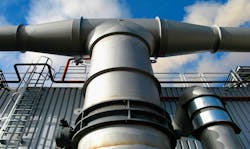Conserving and reusing wastewater has not always been a high priority among for individuals nor for businesses. However, with increasing rising environmental awareness and increasing regulatory pressure to moderate use of natural resources, industrial businesses of all types are looking for a new way to approach their use — and reuse — of water.
Without question, machine shops and other manufacturers can stand with these eco-minded and financially savvy companies. Here are three emerging trends affecting machine shop wastewater, developments you're likely to see 2020 and beyond:
1. Water purification and reuse — Water reclamation and purification ranks high on the list of “things that should have become standard practice in industry a long time ago.” Think of the many ways in which water is put to use in machining and other industrial processes, from cooling equipment and boilers to providing baths for new parts and cleaning agents for old ones.
By implementing efficient water-recycling systems, industrial operations that use water onsite have a substantial opportunity to accomplish two things at once: • Water purification and reuse reduces a business's overall water footprint and, consequently, its impact on the natural environment. • Reducing water and utility consumption translates directly to ongoing cost savings, which then be used to grow the business, rather than to address overhead.
There are numerous examples of small to corporation-sized entities realizing millions of dollars in annual savings by capturing wastewater, treating it, and then using it again. The cutting fluids and coolant systems in machine shops and manufacturing plants are no different.
Some businesses even provide real-time data monitoring to help onsite professionals manage their wastewater purification system, and easily track the amount of pure water they’re able to recover and recirculate within their industrial systems.
2. Stormwater collection — We all have an eccentric neighbor or two with rain barrels dotting their property. At the residential level, capturing stormwater is a convenient way to realize modest savings on water bills. Rainwater is useful for watering grass and plantings, and doing some types of outdoor cleaning.
Collecting rainwater and stormwater will have an even more transformative impact in the commercial sectors, including in machining. Commercial buildings like machine shops and manufacturers typically have significant roof real estate available. In other words, they have plenty of opportunities to install green roofs. Green roofs do two things for a resourceful company: • Green roofs reduce energy use and utility bills by providing economical cooling properties; and, • Green roofs retain huge volumes of stormwater. A green roof just 3.5 inches deep can retain around 55% of rainfall in a given area over the course of a year.
In addition to cost savings, maintaining a green roof to retain stormwater provides a way for companies to supplement the water they use for cooling, cutting, and other industrial purposes.
Stormwater collection doesn’t have to happen on top of a building, however. In 2016 General Motors reported that adding a rainwater capture system saved just one of its factories around $1.64 million annually. Using a combination of a 365-acre site and a series of holding ponds, the plant’s power house uses reverse osmosis to treat the water and send it to the facility for use.
Capturing, treating, and using stormwater creates a beneficial situation for cities, too. Green areas anywhere in an urban area, including on roofs, will reduce substantially the amount of stormwater the city’s sewer and drainage systems have to handle during intense weather events. In this way, large commercial facilities can create a kind of symbiotic relationship with the surrounding built environment.
3. Automation and the IoT — Machining and semiconductor manufacturing are just two industries that rely on a combination of many gallons of water as well as hundreds of different organic and synthetic chemicals. As a result, these manufacturing processes — like rinse baths, waterjet cutting and many others — produce water that is tainted with acids, metals, oxide particulates, and other compounds.
Local ordinances, as well as the EPA, provide guidelines that cover the allowable pollutant levels in wastewater that is discharged back to public sources. In the years since the Clean Water Act, the list of “priority pollutants” has grown to 126.
Given the amount of time and labor required to collect water and take it to a treatment or disposal site, automation is a far more attractive alternative. Automated treatment systems for wastewater, including internet-connected sensors, help businesses to achieve EPA compliance without monitoring all of their sampling equipment in-person.
Then, using a combination of automated pumping systems along with separating agents and filtration membranes, the system can treat wastewater onsite as a background process and prime it for reuse, all with very little human intervention. Automating wastewater treatment equipment means likely energy savings, more complete data sets, and a reduced need to bring chemical additives into the mix.
The new approach — Wastewater from machining processes is not a nuisance; as we’ve seen, it’s an opportunity and a resource. From recycling the water used in industrial processes to helping commercial facilities exist in better harmony with their surroundings, there are a lot of ways for machine shops and other businesses to explore how to use water and wastewater more effectively.
Kayla Matthews writes about the IoT, IIoT, automation and smart technologies for publications like InformationWeek, Manufacturing.net, Robotiq others. To read more from Kayla, follow her personal tech blog, Productivity Bytes.
About the Author
Kayla Matthews
Freelance Journalist
Kayla Matthews writes about the IoT, IIoT, automation and smart technologies at her personal tech blog, Productivity Bytes, and for publications including InformationWeek, Manufacturing.net, Robotiq, and others.
